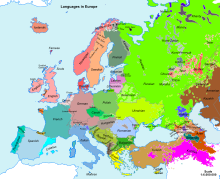
Back Européu permediu estándar AST Standard Average European German Europeo promedio estándar Spanish Standard Average European FIU-VRO Standard Average European Italian 標準ヨーロッパ語 Japanese Standard Average European Romanian Языки среднеевропейского стандарта Russian 標準歐語 Chinese 標準歐洲話 ZH-YUE
This article needs additional citations for verification. (October 2013) |

Standard Average European (SAE) is a concept introduced in 1939 by American linguist Benjamin Whorf to group the modern Indo-European languages of Europe with shared common features.[1] Whorf argued that the SAE languages were characterized by a number of similarities, including syntax and grammar, vocabulary and its use, as well as the relationship between contrasting words and their origins, idioms, and word order, which all made them stand out from many other language groups around the world which do not share these similarities, in essence creating a continental sprachbund. His intention was to argue that the disproportionate amount of SAE-specific knowledge in linguistics created a substantial SAE-centric bias, leading to generalization errors, such as mistaking linguistic features idiosyncratic to the SAE language group for universal tendencies.
Whorf contrasted what he called the SAE tense system (which contrasts past, present and future tenses) with that of the Hopi language of North America, which Whorf analyzed as being based on a distinction not of tense, but on things that have in fact occurred (a realis mood encompassing SAE past and present) compared to things that have as yet not occurred, but which may or may not occur in the future (irrealis mood). The accuracy of Whorf's analysis of Hopi tense later became a point of controversy in linguistics.
- ^ "The Relation of Habitual Thought and Behavior to Language", published in (1941), Language, Culture, and Personality: Essays in Memory of Edward Sapir Edited by Leslie Spier, A. Irving Hallowell, Stanley S. Newman. Menasha, Wisconsin: Sapir Memorial Publication Fund. pp 75–93.
Reprinted in (1956), Language, Thought and Reality: Selected Writings of Benjamins Lee Whorf. Edited by John B. Carroll. Cambridge, Mass.: The M.I.T. Press. pp. 134–159.
Quotation is Whorf (1941:77–78) and (1956:138).
(quotation pp. 77–78) and as Whorf, B. L.The work began to assume the character of a comparison between Hopi and western European languages. It also became evident that even the grammar of Hopi bore a relation to Hopi culture, and the grammar of European tongues to our own "Western" or "European" culture. And it appeared that the interrelation brought in those large subsummations of experience by language, such as our own terms "time," "space," "substance," and "matter." Since, with respect to the traits compared, there is little difference between English, French, German, or other European languages with the 'possible' (but doubtful) exception of Balto-Slavic and non-Indo-European, I have lumped these languages into one group called SAE, or "Standard Average European."